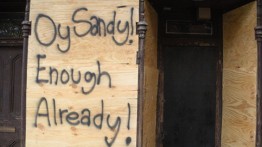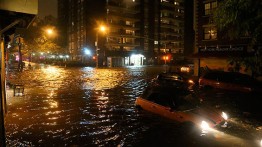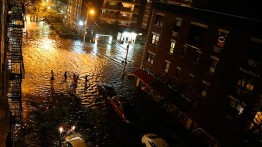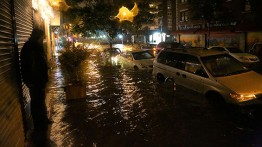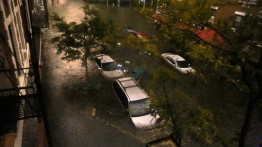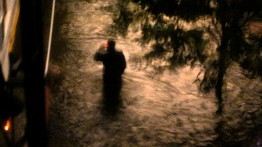Sandy Memories
POSTED ON: November 12, 2012
In response to President Bharucha’s request for the Cooper community to share its collective Sandy experience we received some remarkable images and recollections. Here are some. We will continue to add to this if you would like to share.
I live on the corner of Ave C and 11th St in the East Village. Waters on our corner came to about five feet deep and were moving like rapids, flowing south. At about 8:30 PM the Con Ed plant on the corner had three huge explosions and then all the electricity shut down and the neighborhood went dark. The water peaked about an hour later and then receded quickly over a couple of hours, but all our basements were filled to the brim. Those of us who suffered this damage are still working on clearing out debris, trying to get electrical systems, door buzzers, intercom, phone, cable etc dried out and replaced or restored. It is dirty work, but we all kicked in to make it a communal task. I am very proud of my neighbors and how they/we pitched in to help each other out. I had two generators but no oil or gas: one guy managed to find the right oil and others donated gas, such that I could leave my generators on the street, pumping out basements and providing charging stations for cell phones and laptops (of course we had no cell signal for five days). Our building has fireplaces and neighbors pitched in to provide firewood for us to keep warm for the entire week. I now know more of my neighbors than ever and feel even more at home than I have in the past 25 years in this neighborhood. If there is a silver lining to this cloud of misery, it has to be the bonding of people in the face of adversity.
--Gearoid Dolan, Director, Computer Studio

Homework by candlelight (photo courtesy of Patrick Collingwood)
Patrick Collingwood, a second year architecture student, shared a letter he wrote back to friends and family in the UK. Excerpts are below.
I go out onto the street as the storm has lulled a bit, and relish in this beautifully rare moment: Manhattan in the dark. It captivates me, and I walk and walk. Trees are down and the wind is still strong at times, but there are lots of others like me, out on an adventurous walk. I walk past the building which had it's front torn off, and will be on the news all over the world. It was a bit hairy, the police were cruising round telling everyone to go home, but I just thought it would only last a few hours so had to be experienced then or never.
So no one is really in the mood for hurricane parties, and focusing on work is difficult. The organizing principle of the nine square grid seems a little pointless now. I've been in a sort-of routine of freezing cold showers, staying in an English friend's very smart apartment on the 30th floor, slowly getting through all our food, and having candlelit dinners every night. During the day we migrate uptown to use friend's houses or offices for power and Internet, and try to do work. Yesterday we went to the UN offices, full of war zone veterans in shorts and flip flops who seem completely underwhelmed by the whole thing. We walk back along now clean streets (for once), and get back to an even darker city. The enquiring flashlights at the windows of surrounding towers have stopped, as have the dim candlelit windows. Everyone's basically left the area.
The only light comes from the odd car headlight tentatively navigating their way around streets with no traffic lights, and the reflection in the sky from nearby lit areas. We're now the only ones in our tower, walking up 30 flights of stairs in the dark everyday. I went to raid my digs yesterday for food and clothes, which was even more scary. There were five students left, creeping round the corridors with torches and looking terrified. Everyone had left, and they'd have too soon. No one knew when things would get to normal again. I emptied the fridge and bins, and rushed back to dinner and scrabble in the other dark tower block.
--Patrick Collingwood
Chung-Wei Lee, of the MAarch II program, shared the below video he shot of cars passing on the darkened streets of lower Manhattan.

